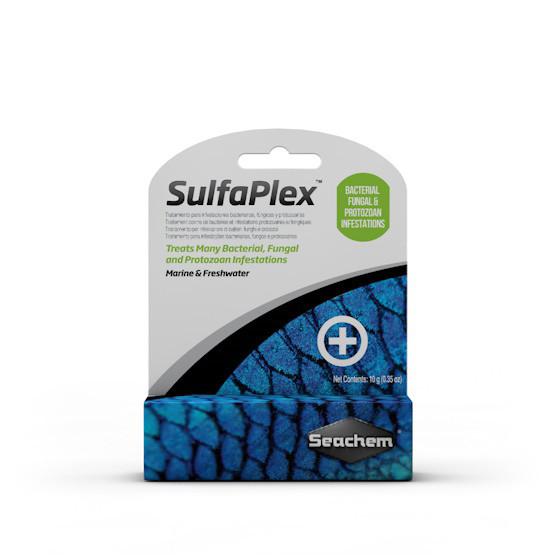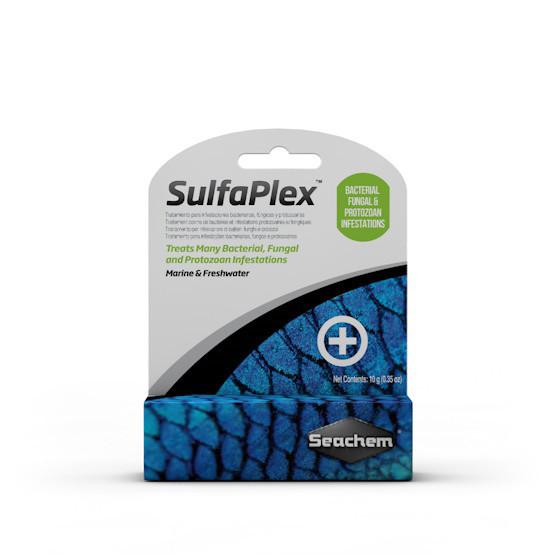Freshnmarine
Seachem SulfaPlex
Seachem SulfaPlex
Couldn't load pickup availability
Specifications:
- Treats many bacterial, fungal, and protozoan infestations
- Broad spectrum antibiotic and anti-fungal medication
- Most effective of the sulfa drugs in saltwater
- Absorbed through gills
Types of Infections Treated
| Parasitic | Fungal | Bacterial | Viral | |
|---|---|---|---|---|
| SulfaPlex |
 X X |
 X X |
 X X |
Directions
Dosing in Water
Remove all invertebrates - these are extremely sensitive to medication. Turn off UV filters, ozone filters, and remove chemical filtration like MatrixCarbon™ and Purigen™. Use 2-3 measures (included) per every every 40 L (10 US gallons). Repeat this dose every 72 hours for a maximum of 3 weeks.
Dosing in Food
SulfaPlex™ is most effective when used in the water, but it can also be added to the food. Feed the medicated food mix (recipe below) every day until the infection clears or up to 3 weeks.
- 1 scoop SulfaPlex™
- 1 scoop Focus™
- 1 tbsp food (preferably pellets or frozen food)
- A few drops of water if using a dry food
To enhance palatability use with GarlicGuard™ or Entice™.
After Treating
When the treatment period is over, SulfaPlex™ can easily be removed using activated filter carbon like MatrixCarbon™. It does not linger in the substrate or filter media of the tank.
Active ingredients: sulfathiazole (69%). Inactive ingredients: excipients (31%)
Common Fish Diseases Treatable with SulfaPlex
Bacterial infection
Fins appear shredded, frayed, or decaying. Fin Rot is frequently mistaken for damage from fin-nipping fish. Contrary to the name, this is actually caused by bacteria, not fungus.Suggested Treatment Period:
3 weeks or until infection clearsAeromonas hydrophilia.
Reddish streaks in the fins near the body or under scales. Common in goldfish. Associated with overcrowding and stress, particularly in goldfish and koi. It can also be caused by a virus.Suggested Treatment Period:
3 weeks or until infection clearsColumnaris
Damaged fins, ulcers and yellowish patches on gills, tissue on head and mouth eaten away. This infection appears gruesome, but is entirely treatable. It is common to see fungus-like tufts around the face and mouth in addition to deterioration of tissue. It is essential to catch this disease early to prevent long-term damage.Suggested Treatment Period:
3 weeks or until infection clearsSpecial Considerations
Columnaris is very contagious. If possible, remove the infected fish to treat separately in a hospital tank.Suggested Treatment Period:
3 weeks or until fungus clearsSpecial Considerations
Fungus is relatively easy to treat and almost never fatal on its own. However, it tends to appear as a secondary infection, meaning there is a more serious disease causing the fish to be susceptible to a fungus.Discoloration of tissue, development of grey or brown “fur” growing on body, listlessness and loss of appetite. This is an unsightly infection that most often appears in bettas.
Suggested Treatment Period:
3 weeks or until infection clearsSpecial Considerations
This infection progresses rapidly and must be treated immediately if you expect your fish to recover. It is very strongly linked to poor water conditions and low temperature in betta bowls.A quick note about bacterial and fungal infections!
Most bacterial infections appear in conjunction with poor water quality or another infection (called a “primary infection”). Do a water test to ensure your water quality is still good and do water changes if necessary to improve your water quality before treating with a medication.
Share


